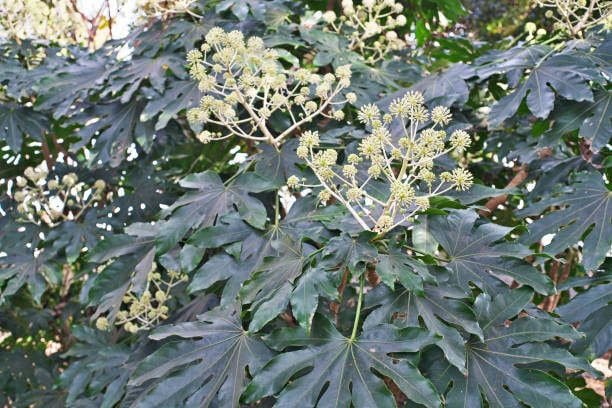25 Incredible Types Of Ferns To Grow In Your Gardens or Homes
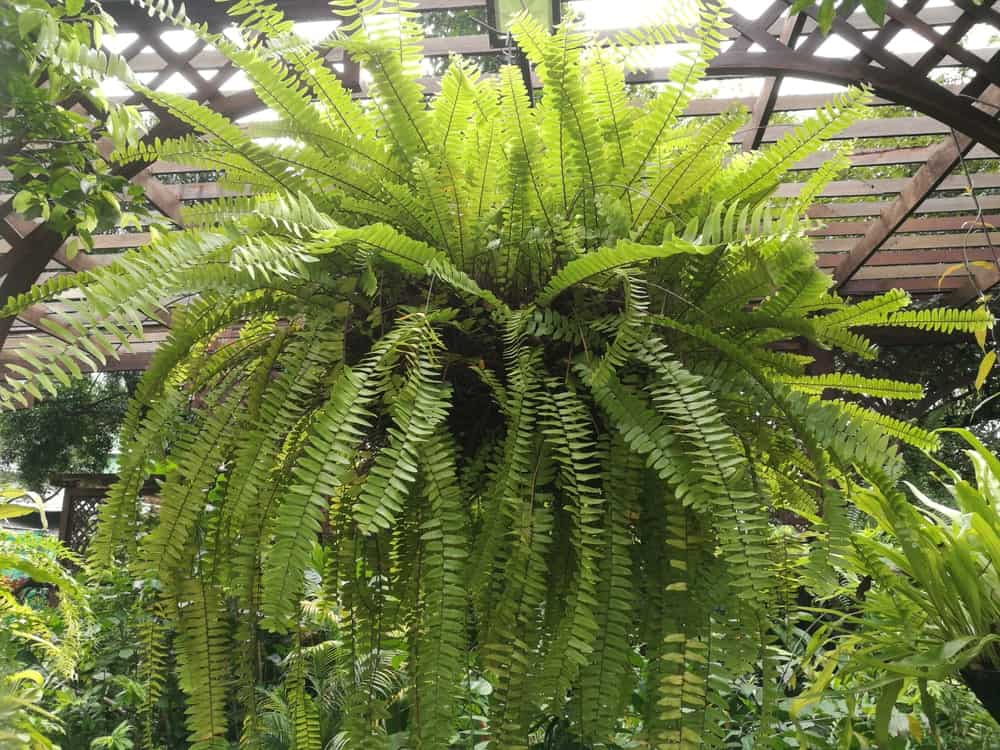
Table of Contents
Ferns are popular for providing a lush and green outline to any garden or bedroom! Ferns are beautiful and ancient plants that have been on the Earth for more than 300 million years! Also, they have an impressive range of shapes, colours, and sizes. But with this, you might ponder which fern to choose for your Garden and whether it is even worth having them in the Garden. Whether you are a horticulturist or anyone who loves the beauty of nature, then this article will surely ignite curiosity in your mind!
We have reached out to specialists and botanists to give you ultimate and reliable knowledge about these plants. In this article, we shall learn how to distinguish their features, their optimal growth conditions, and some tips on caring for them. By the end of this article, you will be a fern expert and on your way to establishing your own beautiful-looking Garden.
List of 25 Ferns to Grow in Your Garden
1. Boston Fern
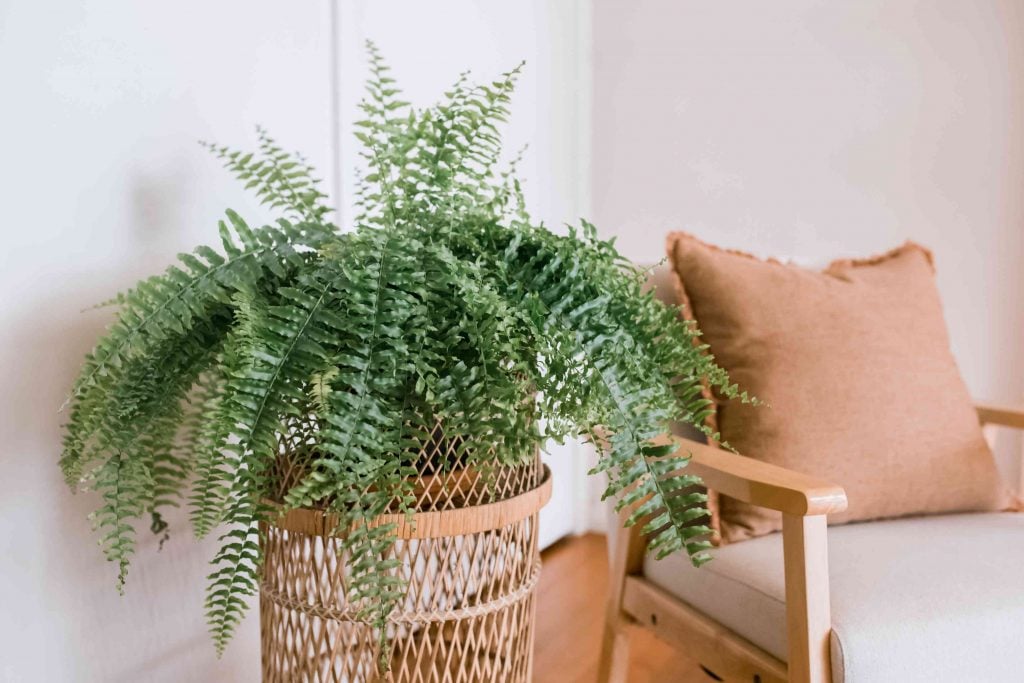
Boston Fern is a common type of indoor fern, distinguished by its lengthy arches and small and feathery leaves. This plant possesses appealing lush foliage that makes it an excellent choice for greenery in any room.
Botanic name: Nephrolepis Exaltata
Suitable Environment: Boston Ferns require bright but indirect light and a humid atmosphere to attain optimal growth. For this reason, keeping them in a moisture-rich room such as a bathroom or kitchen is advised. During the summer months, they can be situated outdoors but not in direct sunlight or exposed to strong winds.
Caring Tips:
- When caring for a Boston Fern, it is essential to ensure that the soil is consistently moist but not waterlogged since this type of plant does not prefer to be submerged in standing water. Regularly misting these leaves will help maintain optimal humidity levels and prevent the leaves from becoming parched.
- Boston Ferns can benefit from periodic fertilisation during the growing season and may need to be repotted every year or two to promote good health and happiness. It becomes important to choose the right kind of fertiliser.
2. Maidenhair Fern
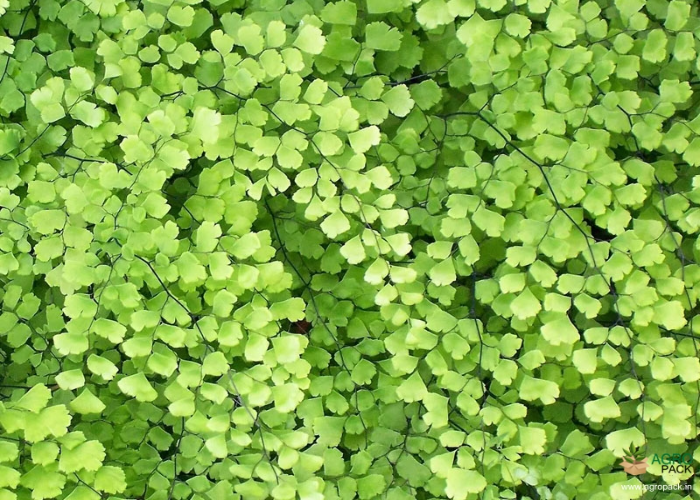
Maidenhair Fern is a delicate and graceful plant that has dark, shiny stems and small, fan-shaped leaves. It’s a popular choice for both indoor and outdoor gardens due to its exquisite foliage and delicate fronds that exude an air of elegance.
Botanic name: Adiantum Raddianum
Suitable Environment: Maidenhair Ferns are quite particular when it comes to their preferred environmental conditions. They thrive in bright, indirect light and humid atmospheres. Therefore, you can place them near a window where they can receive filtered sunlight, or you can keep them in a shaded outdoor area during the summer months. However, direct sunlight and strong winds can damage their fragile fronds, so they should be protected against these elements.
Caring tips:
- To keep your Maidenhair Fern healthy, it’s important to maintain the moisture in the soil at a consistently moist level but not to overwater it, as it doesn’t like to sit in standing water. It would be best if you also sprayed the foliage regularly to maintain the humidity levels and prevent the leaves from becoming dry. It is advised to use a moderately pressured hose or one whose pressure can be adjusted.
- When given the right care and conditions, your maidenhair Fern will flourish and add a beautiful, natural touch to your home and gardens.
3. Bird’s Nest Fern
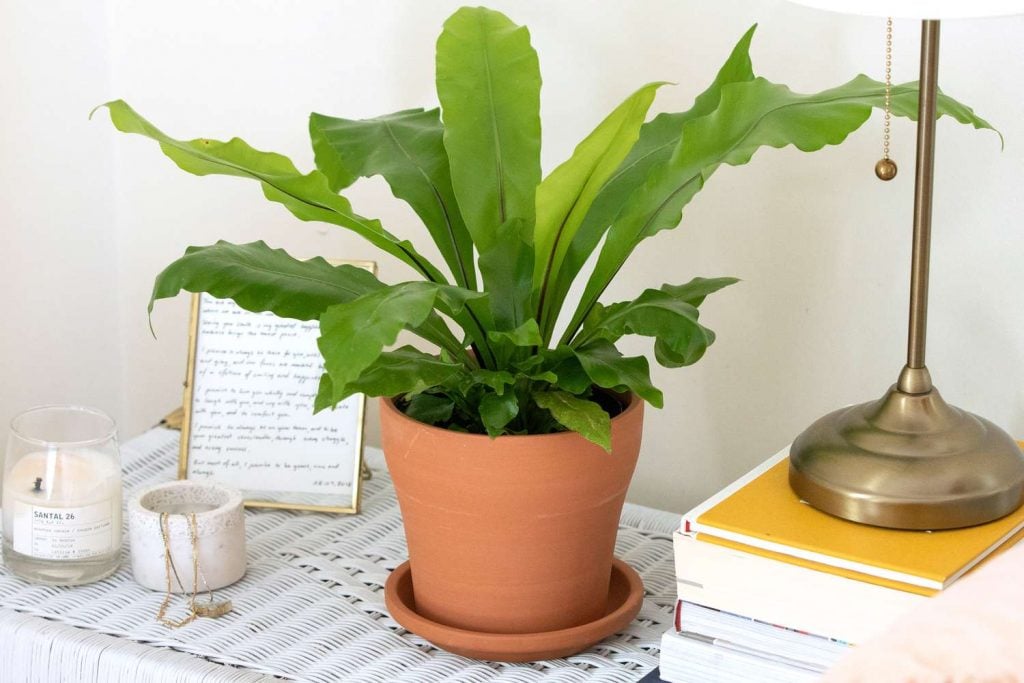
The name of the Bird’s Nest Fern arises from its rosette-shaped fronds, which resemble a bird’s nest. Aesthetically pleasing, the plant’s leaves have a lustrous quality and need minimal care, hence making it a sought-after houseplant.
Botanic name: Asplenium Nidus
Suitable Environment: For optimal growth, it is recommended to place the Bird’s Nest Fern in a location that receives bright but indirect light. As this species of fern thrives in high humidity, it is advantageous to keep it in areas such as the kitchen or bathroom, where the air is abundant in moisture.
Caring tips:
- To maintain the Bird’s Nest Fern, ensure the soil is consistently moist but not waterlogged, as it does not take kindly to water accumulation.
- The fern cannot sustain great variation in temperature and humidity and hence need a uniform environment.
4. Australian Tree Fern
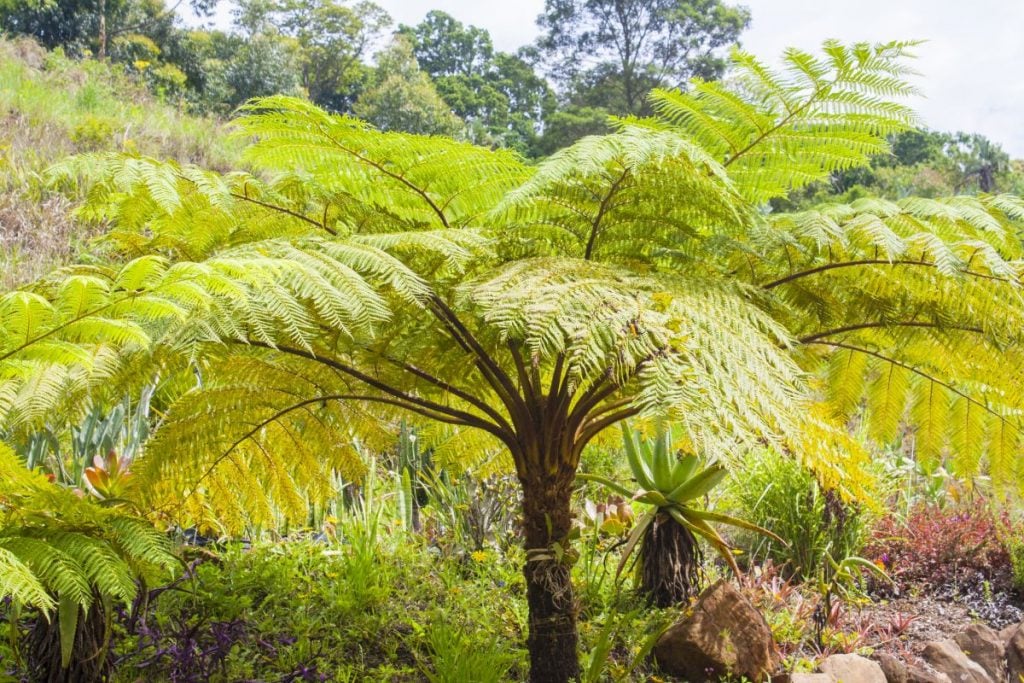
The Australian Tree Fern has a slender and woody trunk that is crowned by an expansive, gracefully curving cluster of leafy fronds capable of extending up to an impressive length of 3 meters. It is known for its aesthetic appeal, which is used as a decorative element in both outdoor and indoor spaces.
Botanic name: Cyathea Cooperi
Suitable Environment: To ensure the growth of the Australian Tree Fern, it is important to provide it with a habitat that offers shade or partial shade, provided with direct sunlight and gusty winds. They flourish in a regular misting atmosphere and the maintenance of consistently damp yet not waterlogged soil.
Caring tips:
- To ensure the longevity and vibrancy of your Australian Tree Fern, it is crucial to maintain its health through proper care. Avoid waterlogging the soil and keep it consistently moist instead, as the fern cannot tolerate stagnant water.
- Use a well-balanced fertilizer to feed the plant once a month during its growing season. Additionally, periodically repotting the fern can promote its well-being.
5. Japanese Painted Fern
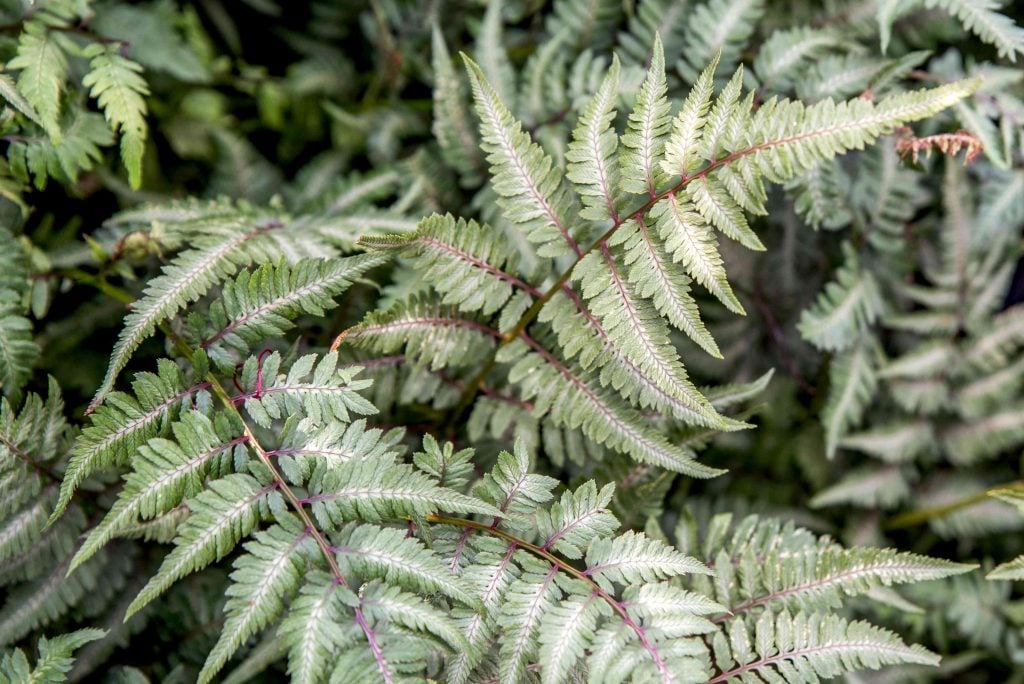
The Japanese Painted Fern is an arresting type of fern that boasts silvery-blue fronds adorned with a medley of hues such as purple, red, and green. The fern sheds its leaves during the winter and regains them in the spring, making it a favoured option for introducing seasonal gardens.
Botanic name: Athyrium niponicum
Suitable Environment: The Japanese-painted fern favours a shaded or partially shaded locale that has soil that drains well. It can be cultivated in containers or planted in the ground and is a popular preference for woodland gardens, rock gardens, and shady borders.
Caring tips:
- The Japanese Painted Fern requires consistent soil moisture, but not to the point of waterlogging, as it disfavors being submerged in standing water.
- Although the Japanese Painted Fern demands little attention, it may be necessary to divide it every few years to promote its well-being and prevent overcrowding. Providing it with appropriate care, this botanical marvel will serve as a spectacular and vivid supplement to your Garden.
6. Kimberly Queen Fern

The Kimberly Queen Fern is a specie of fern exuding elegance and grace and possesses the ability to imbue both indoor and outdoor environments with a mesmerising touch of tropical splendour. This plant has luxuriant fronds in a deep green resulting in a truly enchanting garden display.
Botanic name: Nephrolepis Obliterate
Suitable Environment: These types of fern flourish in balmy and moisture-laden habitats, rendering it a prime selection for tropical and subtropical zones. In regions with cooler climates, this fern is frequently cultivated indoors, lending a touch of lushness to living spaces. They need indirect sunlight as they can die in direct sunlight.
Caring tips:
- Maintain moisture content in the soil, but avoid excessive watering. Proper drainage mechanisms avoid the risk of waterlogging, which can lead to the decay of the plant’s roots.
- To preserve the fern’s aesthetic appeal, it is essential to eliminate any discoloured or impaired fronds routinely. Groom the plant by delicately pruning away any brown tips or withered edges, ensuring its regular radiance and vigour.
7. Autumn Fern
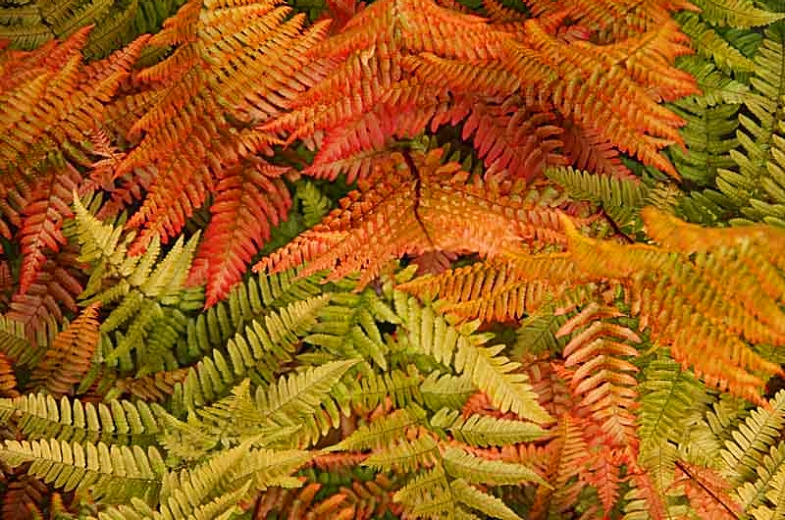
Autumn Fern is a mesmerising species of fern, renowned for its captivating foliage that gets various hues during the enchanting autumnal period. This particular fern showcases fonds that unfurl in an amazing coppery-red tint, eventually maturing into a vibrant, lush green shade.
Botanic name: Dryopteris erythrosora
Suitable Environment: The Autumn Fern flourishes in areas of partial to complete shade, rendering it a superb option for woodland gardens or locations with filtered sunlight. It needs soil that drains adeptly while being enriched with a good amount of organic substances. This fern can endure a wide spectrum of temperatures, thereby being suitable for diverse regions.
Caring tip:
- Maintain a state of soil moisture that remains consistently damp, ensuring it avoids excessive watering. During dry seasons, give them extra water and never let the soil dry.
8. Ostrich Fern
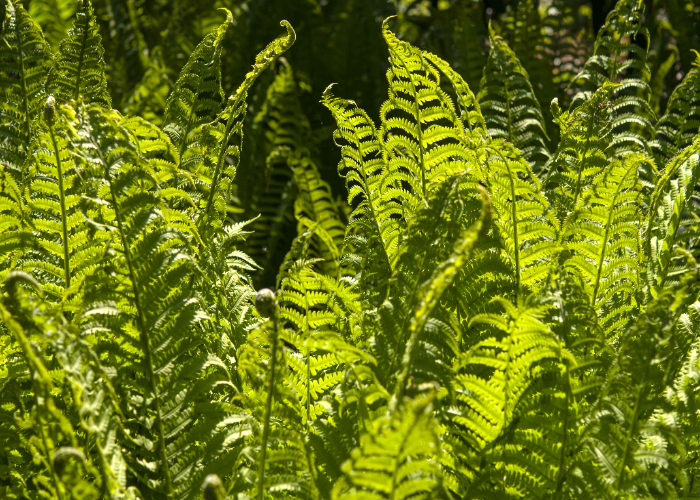
The Ostrich Fern is a magnificent type of fern that is widely acclaimed for its extraordinary aesthetic. With its vibrant green fronds, it unfurls in a manner similar to an ostrich-like name. As a deciduous fern, it possesses the ability to attain remarkable altitudes, instilling a sense of theatricality in any garden or landscape it graces.
Botanic name: Matteuccia Struthiopteris
Suitable Environment: The ostrich Fern flourishes in damp and shaded surroundings, rendering it an exemplary selection for woodland gardens or regions with abundant moisture. It needs loamy soil that offers efficient drainage while being rich in organic substances. This particular species is native to cooler regions and shows suitability in such environments.
Caring tips:
- To cultivate the Ostrich Fern, choose a planting site that provides partial or complete shade. It needs an environment where sunlight is filtered or received indirectly. In regions with high temperatures, full shade can prove beneficial, shielding the fern from excessive heat and ensuring its well-being.
- For the optimal nourishment of the Ostrich Fern, furnish it with loamy soil that possesses excellent drainage properties. Add organic matter, such as compost or leaf litter, into the soil composition to bolster fertility and augment moisture retention capabilities. To further promote its growth and vitality, utilisation of balanced organic fertilisers during the active growing season proves advantageous.
9. Asparagus Fern
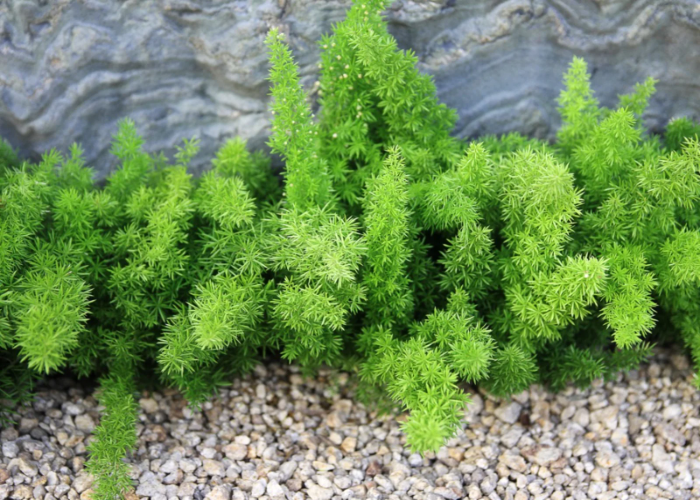
The Asparagus Fern is an enchanting fern-like plant that adds an air of refinement to any interior or exterior space. Despite its name, it is not a true fern but belongs to the Asparagus genus. These types of ferns show delicate, feathery leaves that gracefully craft a visually appealing display.
Botanic name: Asparagus setaceus
Suitable Environment: The Asparagus Fern flourishes across a variety of habitats, proving itself a versatile selection for both interior and exterior landscapes. It prefers bright, indirect light but can tolerate some shade. These types of ferns need warmer temperatures and mild climates.
Caring tips:
- Put these types of ferns in a bright and indirect-lighted location. Avoid the harsh rays of direct sunlight as they possess the potential to damage the weak fronds. If you are growing them indoors, adjust them near the window towards the north or east for an optimum degree of light absorption.
- This plant thrives best in temperatures between 18°C to 24°C (65°F to 75°F). Ir needs moderate to high humidity; thus, regularly misting them would help.
10. Holly Fern
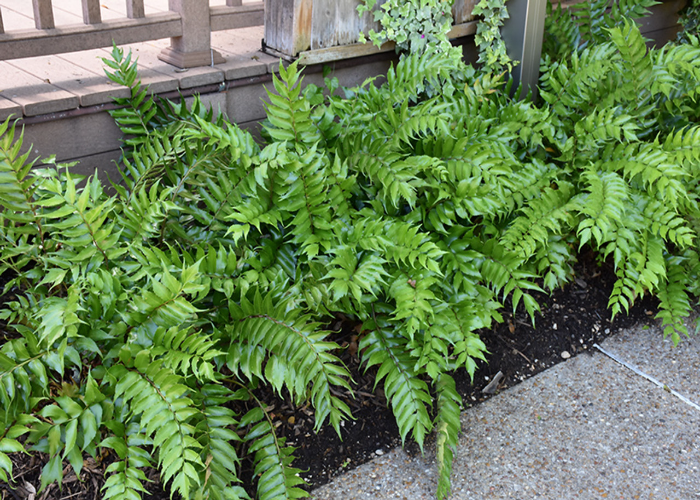
The Holly Fern is an extraordinary species of fern that gives a touch of refinement and texture to any garden or landscape. Its lustrous and leathery fronds have a unique form, sporting a luxuriant and deep green hue. This perennial fern possesses a shiny texture and charm that is admired throughout the year.
Botanic name: Cyrtomium Falcatum
Suitable Environment: The Holly Fern flourishes in areas of partial shade to complete shade, rendering it a superb selection for gardens nestled within woodlands or suited best with filtered sunlight. It prefers soil that drains effectively while maintaining a mildly acidic to neutral pH. These types of ferns possess remarkable adaptability, enabling them to withstand diverse temperature ranges, thereby making them well-suited for various regions.
Caring tips:
- Cover the area of the plant’s foundation with a covering of natural mulch, such as decaying leaves or nourishing compost. The act of mulching helps in the retention of moisture, regulates the temperature of the soil, and curbs the growth of unwanted weeds.
- Apply a well-balanced, gradual-release fertiliser during the spring season to give the fern the vital nourishment it needs for optimal growth. Adhere strictly to the dosage and application instructions provided by the manufacturer to ensure precise and efficacious fertilisation.
11. Tassel Fern
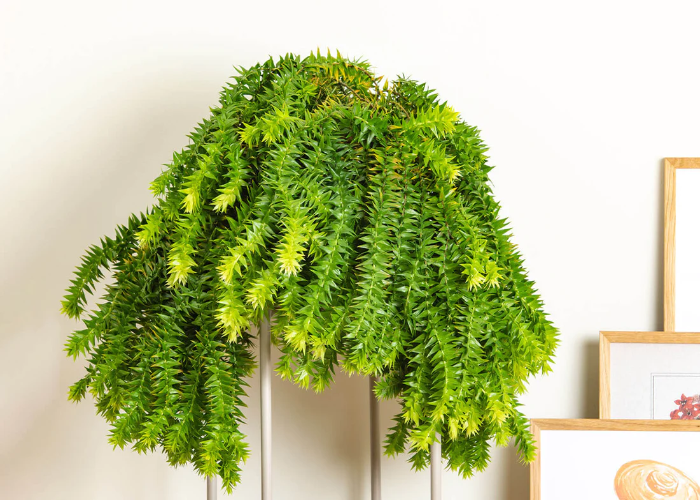
The Tassel Fern is a unique species of fern renowned for its distinctive appearance and elegant fronds. This evergreen fern showcases glossy, deep green foliage that forms a compact, vase-shaped cluster, bringing a touch of sophistication and textural interest to any garden or landscape.
Botanic name: Polystichum Polyblepharum
Suitable Environment: The Tassel Fern flourishes in partially shaded to shaded areas, making it an exceptional option for woodland gardens, shaded borders, or places with less sunlight. It prefers moist, well-drained soil that is enriched with organic matter. This fern species is native to East Asia and has successfully adapted to temperate climates.
Caring tips:
- The Tassel Fern thrives in moderate temperatures, typically ranging from 10°C to 24°C (50°F to 75°F). It needs moderate to high levels of humidity. To ensure adequate moisture, it is beneficial to mist the fronds regularly or position the plant near a humidifier.
- It is important to regularly remove any damaged or brown fronds from the Tassel Fern to maintain its appearance and promote new growth.
12. Rabbits Foot Fern
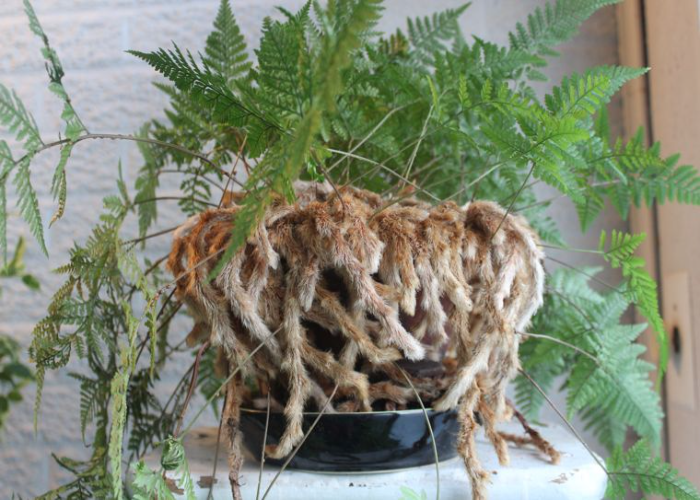
The Rabbits Foot Fern stands out as unique species of fern, renowned for its extraordinary and velvety rhizomes that resemble the paws of a rabbit. This characteristic is mixed with delicate, lace-like fronds, making it a popular option for adding a touch of charm to any interior and exterior environment.
Botanic name: Davallia Fejeensis
Suitable Environment: These types of ferns thrive in warm and humid environments. They are best for indoor and as well as outdoor areas with moderate temperatures. Originating from tropical domains, this fern variant requires specific care to ensure proper replication.
Caring tip:
- This plant thrives best in temperatures between 18°C to 24°C (65°F to 75°F). It needs moderate to high humidity; thus, regularly misting them would help.
13. Cinnamon Fern
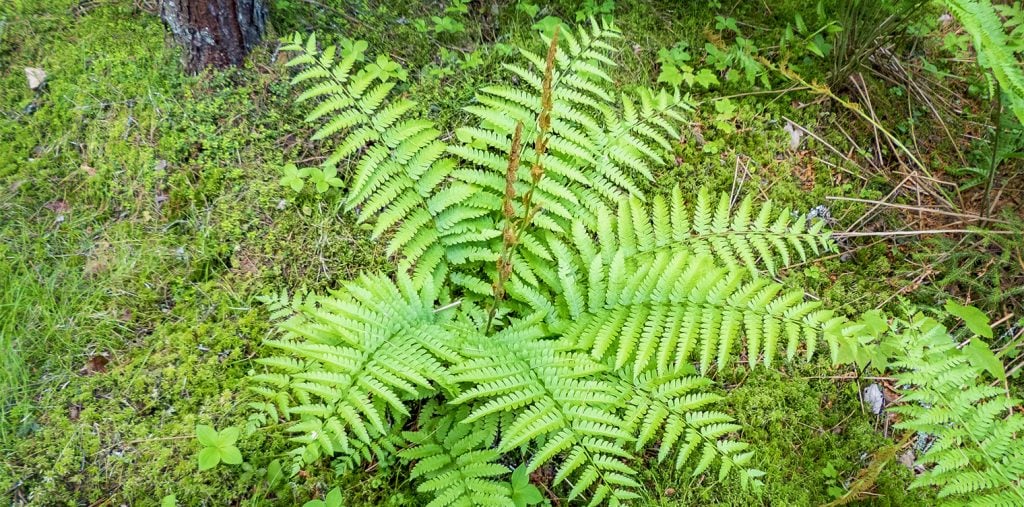
The mesmerizing Cinnamon Fern, an enchanting species of fern, has a distinctive appearance and ornamental value. This deciduous fern variety showcases resplendent, cinnamon-hued fertile fronds that gracefully unfurl during the arrival of spring. Throughout the season, the leaves turn into a deep green hue, thereby showing a touch of refinement upon any garden or landscape.
Botanic name: Osmundastrum Cinnamomeum
Suitable Environment: These types of ferns flourish in damp and shadowy environments. These ferns variant has an indigenous heritage to the continent of North America and has adapted itself to the temperate climatic conditions. It prefers slightly acidic to neutral soil but can endure moderate dampness.
Caring tips:
- To cultivate the Cinnamon Fern, choose a planting site that provides partial or complete shade. It needs an environment where sunlight is filtered or received indirectly.
- Generally, the Cinnamon Fern doesn’t need periodic fertilisation. Nonetheless, if there is a nutrient deficiency in the soil, you may add slow-acting and well-balanced fertilisers during the growing season.
14. Hart’s Tongue Fern
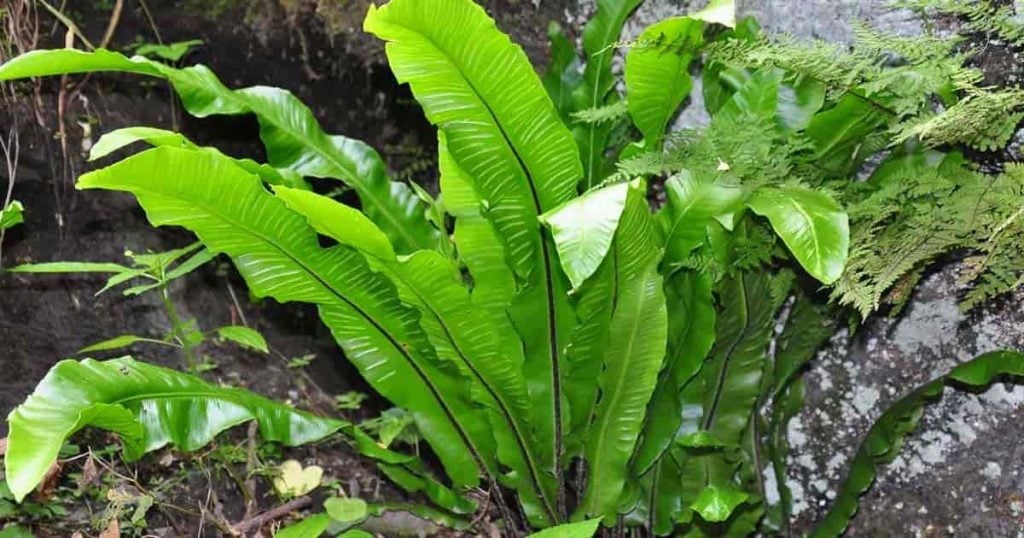
The Hart’s Tongue stands as an extraordinary and charming plant species that spreads an air of sophistication upon every Garden and landscape. Its unique elongated fronds with smooth and sleek edges that resemble the shape of a deer’s tongue get its name and make it an esteemed addition to the Garden.
Botanic name: Asplenium Scolopendrium
Suitable Environment: The Hart’s Tongue Fern flourishes in areas where there are partially shaded to shaded regions. It is a perfect choice for woodland gardens, rockeries, or borders cast. It needs well-drained soil that is rich with nourishing organic components. It is native to Europe and is adapted to temperate climates.
Caring tip:
- Keep the Hart’s Tongue Fern within by partial shade or filtered sunlight. Exercise caution to protect it from the harsh glare of direct, intense sunbeams, for such luminosity may harm its delicate fronds, leading to undesirable scorchings.
15. Southern Maidenhair Fern
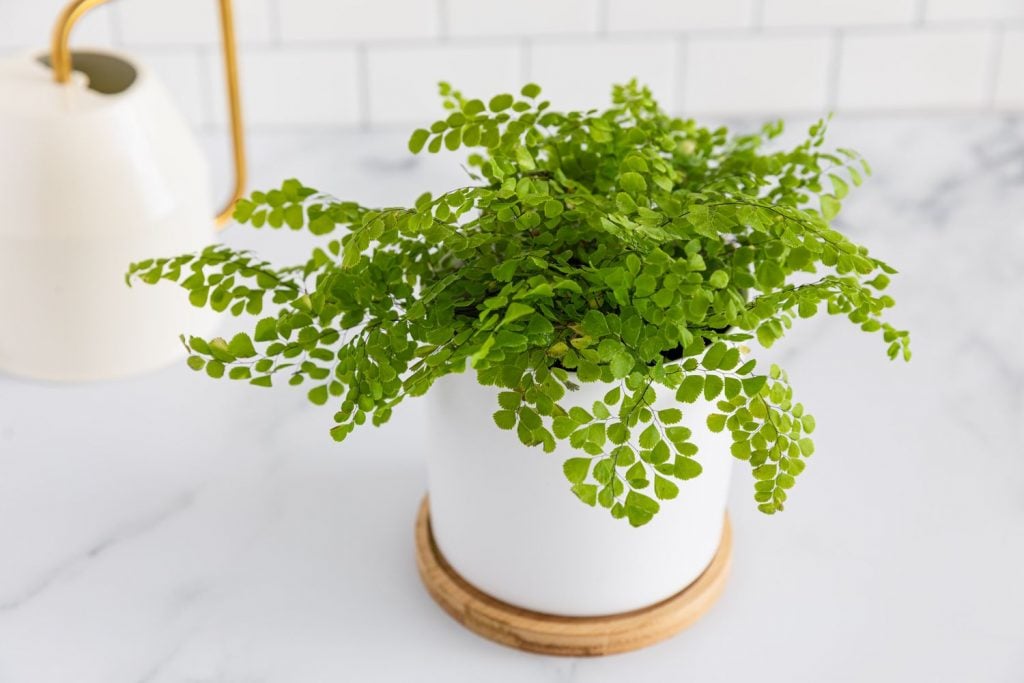
The Southern Fern is a fragile and charming ferm species that add elegance to any garden or indoor place. The fern sheds its leaves during the winter and regains them in the spring, making it a favoured option for introducing seasonal gardens. Except these, they have fan-shaped leaves that give a feathery texture that evokes a sense of delicate enchantment.
Botanic name: Adiantum Capillus-Veneris
Suitable Environment: These types of ferns also thrive in warm and humid environments. They are best for indoor and as well as outdoor areas with moderate temperatures. During the summer season, the fern can be relocated outdoors but within a shaded area, sheltered from the perils of direct sunlight and gusty winds.
Caring tip:
- The practice of trimming removes any fronds that display any sign of damage or yellowing part. This will encourage new growth and give it an aesthetic appeal.
16. Shield Fern
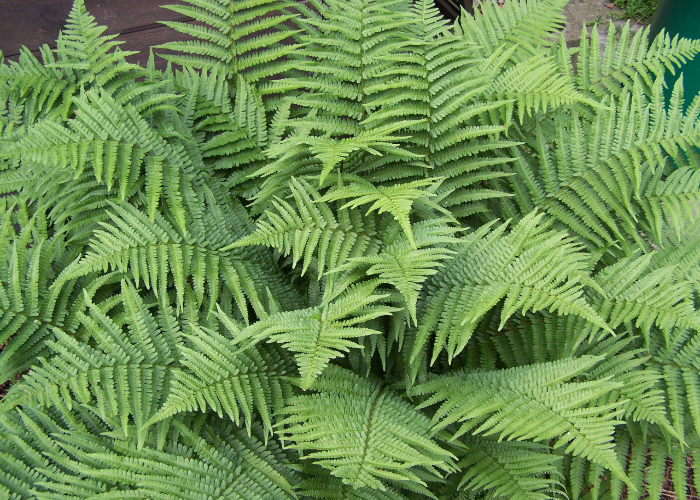
The Shield Fern showcases its mesmerising and distinctive characteristics, emerging as a distinctive botanical species that gracefully infuses any garden or landscape with an essence of natural refinement! With its striking fronds resembling a shield in both shape and shine, it gives a sense of timeless beauty.
Botanic name: Polystichum Setiferum
Suitable Environment: These types of ferns flourish in the embrace of partially shaded to shaded regions and need well-drained soil brimming with organic matter. These fern species find their origins scattered across corners of the world but are well-adapted to temperate climates.
Caring tip:
- Spray the leaves often to maintain the humidity levels and save them from drying. It is crucial to avert the water from accumulating in the centre of the rosette as it can cause the plant to decompose.
17. Christmas Fern
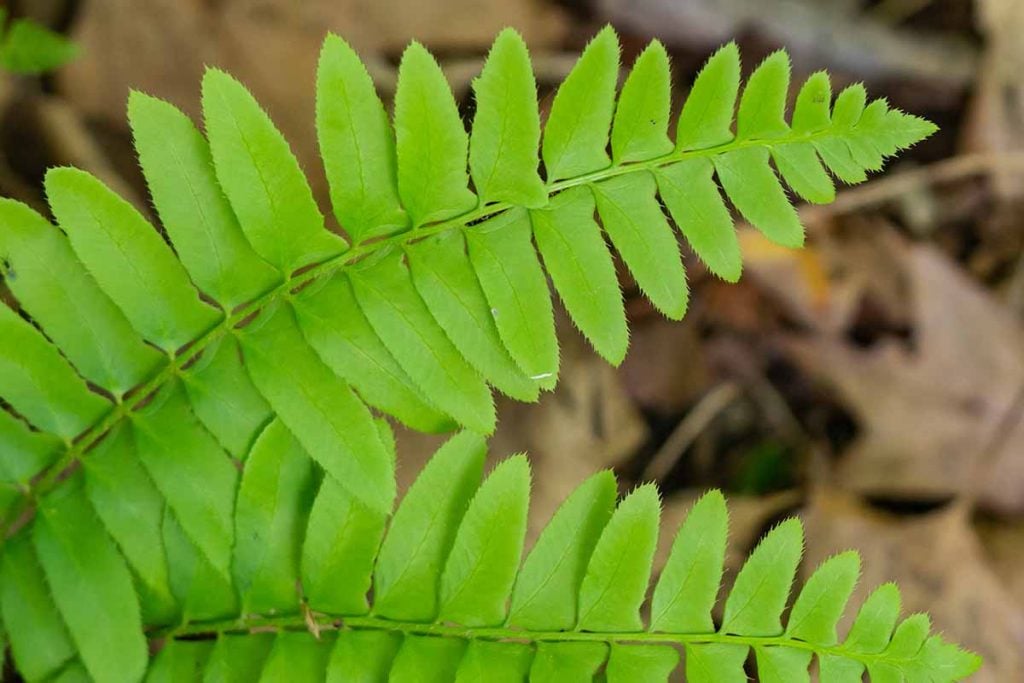
The Christmas Fern, renowned for its enchanting evergreen nature, settles upon any garden or landscape and adds charm to joyous festivities. With its glossy and leathery fronds and symmetrical growth, it improves the visual impact on the person seeing it. It brings a sense of nourishment around during the holiday season.
Botanic name: Polystichum Acrostichoides
Suitable Environment: These types of ferns flourish in partially shaded to shaded places, making them an addition to woodland gardens, shaded borders, or locations adorned with the gentle caress of filtered sunlight. It has a preference for well-draining soil nourished with organic elements.
Caring tip:
- Christmas Ferns are quite sensitive to changes in temperature and humidity, so it’s crucial to keep them in a consistent environment and avoid placing them near heaters or air conditioning vents.
18. Giant Chain Fern

The Giant Chain Fern is an amazing and attractive specie that is demanded in every Garden or landscape. Showing a big size and ambience, this fern leaves a lasting impression on anyone watching this plant. Its presence adds a touch of majesty to its environment.
Botanic name: Woodwardia Fimbriata
Suitable Environment: This Fern flourishes in damp and shadowy environments. It prefers soil that drains effectively while maintaining a mildly acidic to neutral pH. These types of ferns need warmer temperatures and mild climates.
Caring tip:
- Maintaining a stable environment is also vital, as Gaint Chain Ferns prefer areas with consistent temperatures that are not too hot or cold. Be sure to shield the plant from drafts and temperature fluctuations as well.
19. Royal Fern
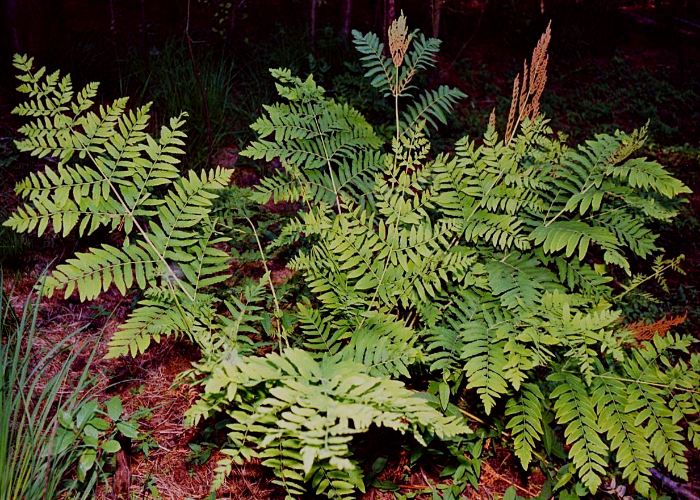
The Royal Fern, an esteemed and regal member of the fern family, shows upon any garden or landscape and adds an undeniable aura of magnificence and refined grace. Standing tall with an impressive height and luxuriant, feather-like fronds, this fern effortlessly captures attention and transfer an air of sophistication upon its surrounding.
Botanic name: Osmunda Regalis
Suitable Environment: The Royal Fern flourishes in moist to wet habitats, making it a perfect option for bog gardens, pond perimeters, or regions blessed with consistent moisture. Originating from the landscapes of Europe, this fern species exhibits remarkable adaptability to thrive within temperate climates, showcasing its well-adapted to the natural rhythms of the seasons.
Caring tips:
- Gently spread a covering of organic mulch, such as decomposed leaves or nutrient-rich compost, encircling the foundation of the fern.
- This practice of mulching serves the purpose of preserving optimal moisture levels, moderating the temperature of the soil, and effectively stopping the growth of unwelcome weeds.
- It is important to ensure that the soil possesses excellent drainage capabilities and abounds with generous quantities of organic substances.
20. Bracken Fern
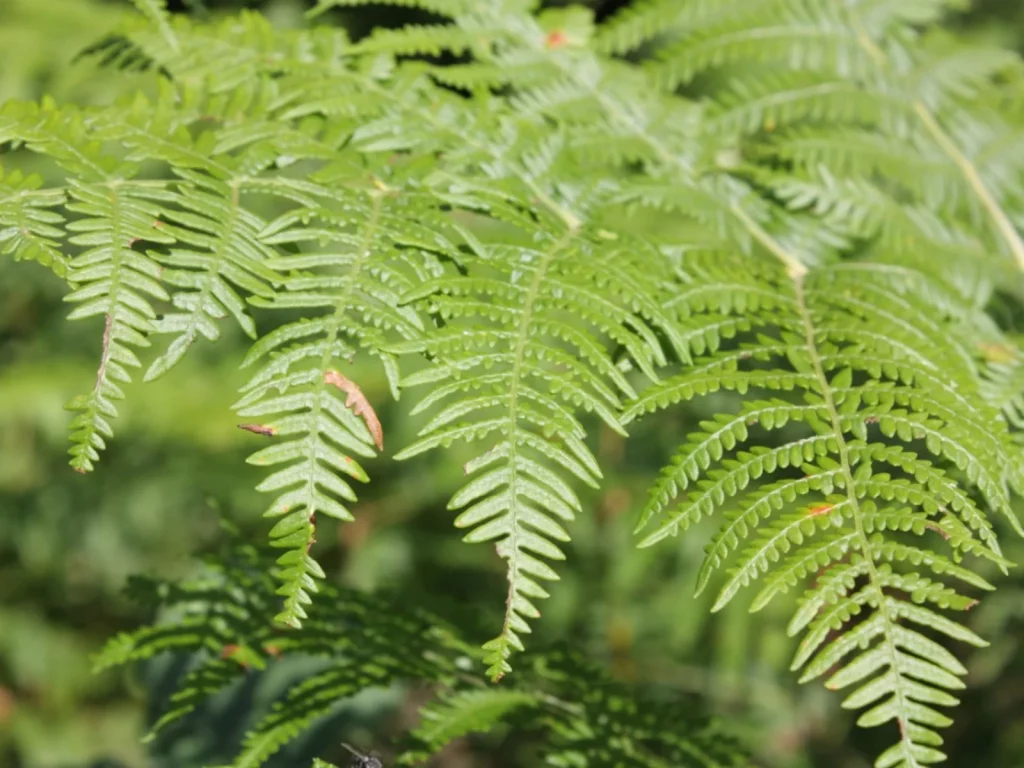
Bracken Fern, a hardy member of the fern kingdom, gives a sense of wild beauty to the diverse landscapes it inhabits. Characterised by its unique triangular fronds and fast-growing tendencies, this fern unfailingly captures attention with its remarkable beauty.
Botanic name: Pteridium Aquilinum
Suitable Environment: The Bracken Fern showcases versatility, effortlessly found in various habitats that include woodlands, meadows, and open expanses. Hailing from the regions of Europe, it shows an adaptation to temperature and climate.
Caring tips:
- Add organic matter, such as compost or leaf litter, into the soil composition to bolster fertility and augment moisture retention capabilities.
- To further promote its growth and vitality, utilisation of balanced organic fertilisers during the active growing season proves advantageous.
21. Lady Fern
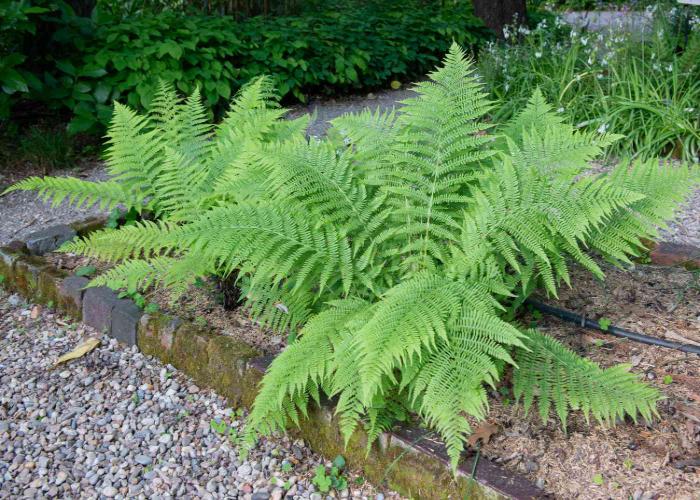
Lady fern is an enchanting and refined fern species that adds a touch of grace to every Garden or landscape. This feature is combined with delicate, lace-like fronds, making it a popular option for adding a tint of charm to any interior and exterior environment.
Botanic name: Athyrium Filix-Femina
Suitable Environment: Originating from the realms of Europe, this fern species has mesmerising ferns that flourish in areas blessed with partial shade or an ambience of shadows, rendering it an exquisite selection for enchanting woodland gardens, twilight-kissed borders or regions with gentle sun rays.
Caring tips:
- Pruning back old or withered foliage is best done in early spring, before the start of the growing season. Consistent grooming practices contribute to the fern’s overall health and vitality.
- To further promote its growth and vitality, utilisation of balanced organic fertilisers during the active growing season proves advantageous.
22. Silver Lace Fern
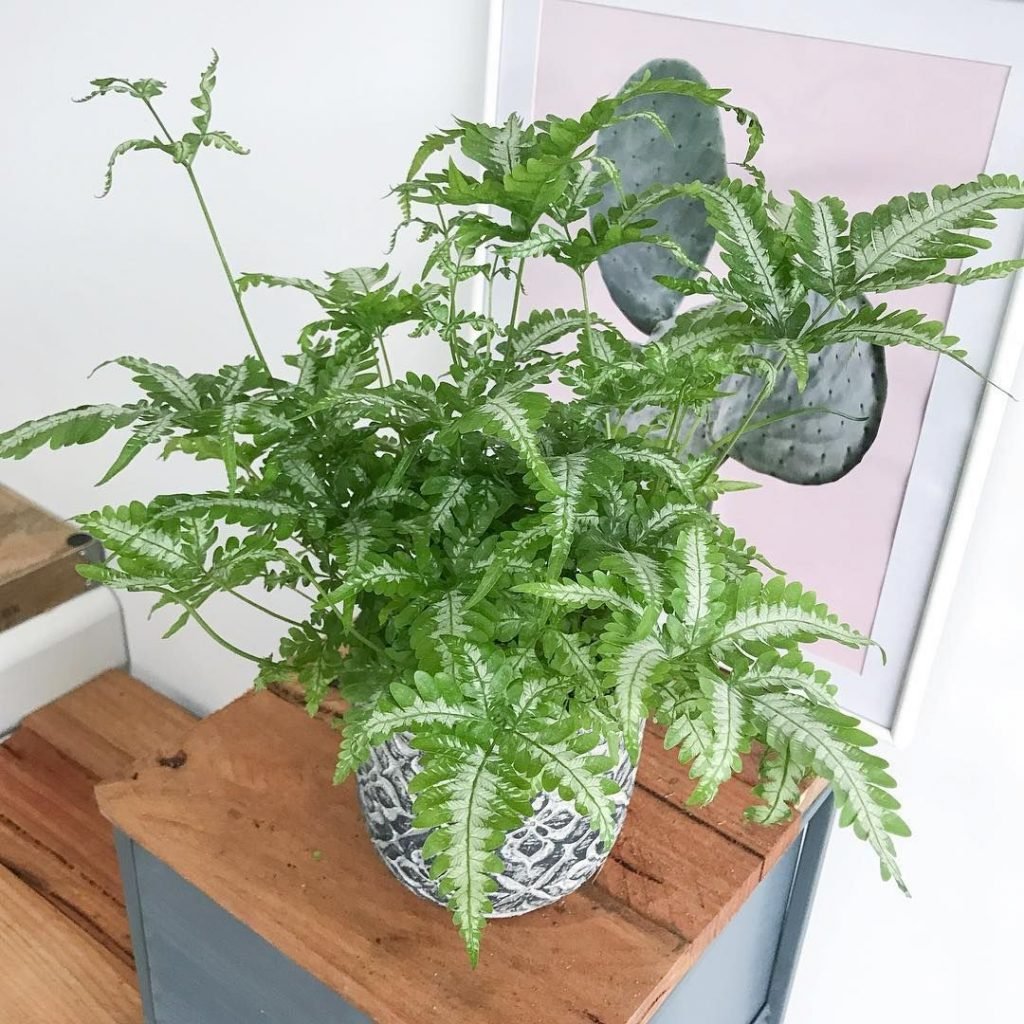
Silver lace fern is a common and fragile fern species. They not only add a touch of sophistication and elegance to any garden or indoor space, but also they give a sense of eternal beauty to its surrounding.
Botanic name: Pteris Ensiformis
Suitable Environment: These types of ferns survive best in partially shaded to shaded areas, making them a perfect plant for rooms with windows, shaded patios or gazebos. They need well-draining soil that should be rich in organic matter.
Caring tips:
- Transplant the Silver Lace Fern after every two to three years, ideally during the spring. Opt for a bigger pot that has efficient drainage.
- Just make sure you loosen the roots before putting them in another pot; it will give them extra life.
23. Northern Maidenhair Fern
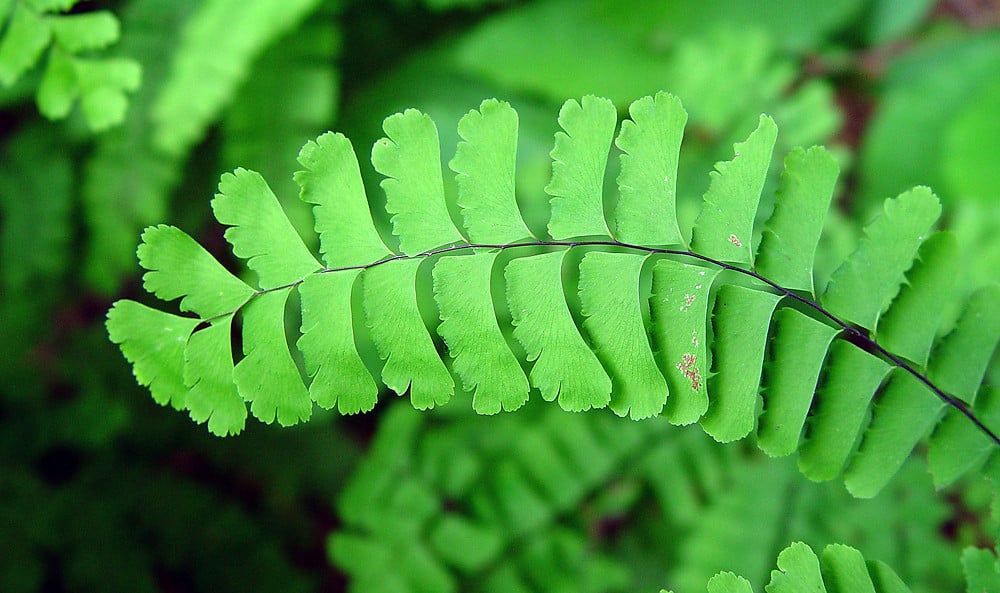
The Northern Maidenhair Fern is a charming and fragile fern that brings grace and an outline to any garden or room. They have fan-shaped fronds and delicate leaflets. This fern species is native to North America and thrive best in warm climates.
Botanic name: Adiantum Pedatum
Suitable Environment: These types of ferns need shaded areas and partially shaded areas. The perfect areas for them can be woodland gardens, shaded borders or areas with filtered sunlight like a gazebo.
Caring tip:
- To nurture the Northern Maidenhair Fern optimally, it is important to upload an equilibrium of moisture within the soil. Watering the fern becomes requisite when the uppermost layer of the soil suffers from dryness.
24. Button Fern
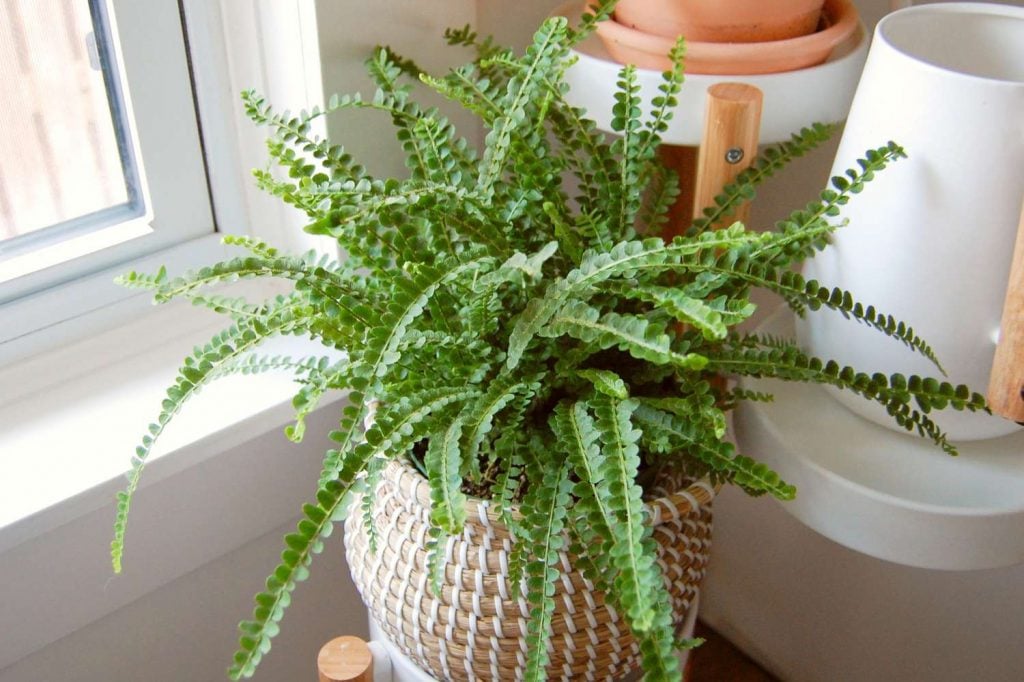
The Button is a diminutive species of fern that bestows a sense of allure and brings a touch of greenery to any enclosed environment or shaded horticultural area. With its small and round leaves, this fern establishes a mesmerising aura.
Botanic name: Pellaea Rotundifolia
Suitable Environment: These types of ferns thrive within the regions of partially shaded or fully shaded domains. The Button Fern emerges as an optimal selection for indoor environs, terrariums, or areas of shaded respite in the open air.
Caring tips:
- They need a temperature between 15°C to 24°C (59°F to 75°F). It also requires a high level of humidity, so it is suggested to place this plant on a tray filled with small stones and water.
- In regions with high temperatures, full shade can prove beneficial and shielding the fern from excessive heat can ensure its well-being.
25. Broad Buckler Fern

Last but not least, we have Board Buckler Fern. This botanical marvel suits everywhere, including woodland regions and shaded gardens. This fern adds an irresistible allure, casting a wonderful aura that resonates with timeless grace and sophistication throughout its environment.
Botanic name: Dryopteris Dilatata
Suitable Environment: They flourish in partially shaded or completely shaded areas. It has an exclusive need for soil with efficient drainage mechanisms coupled with a rich abundance of organic matter.
Caring tip:
- In order to uphold the fern’s aesthetic beauty, it is vital to eliminate any impaired or discoloured fronds periodically. Regularly remove lifeless or withered foliage during the onset of spring, prior to the emergence of fresh growth.
Summing Up
All types of ferns present many possibilities when it comes to adding the aesthetic appeal and sophistication of gardens and interior areas. With their luxuriant foliage, diverse forms, hues, and shapes, ferns have impressed people. This article has valuable insights into some of the finest fern varieties for your Garden, accompanied by care recommendations for each distinct type. Ranging from the widely renowned Boston Fern flaunting to the fragile and graceful Maidenhair Fern, each fern possesses its own distinctive characteristic and preferred cultivation conditions.
Ferns need attention to factors such as light, humidity, and soil moisture. Upholding optimal humidity levels and ensuring well-drained soil is pivotal to fostering their optimal development. Regular misting, periodic fertilization, and occasional repotting are necessary practices to sustain the health of ferns.
By adding ferns to your Garden or interior space, you will have a visually striking and dynamic environment.

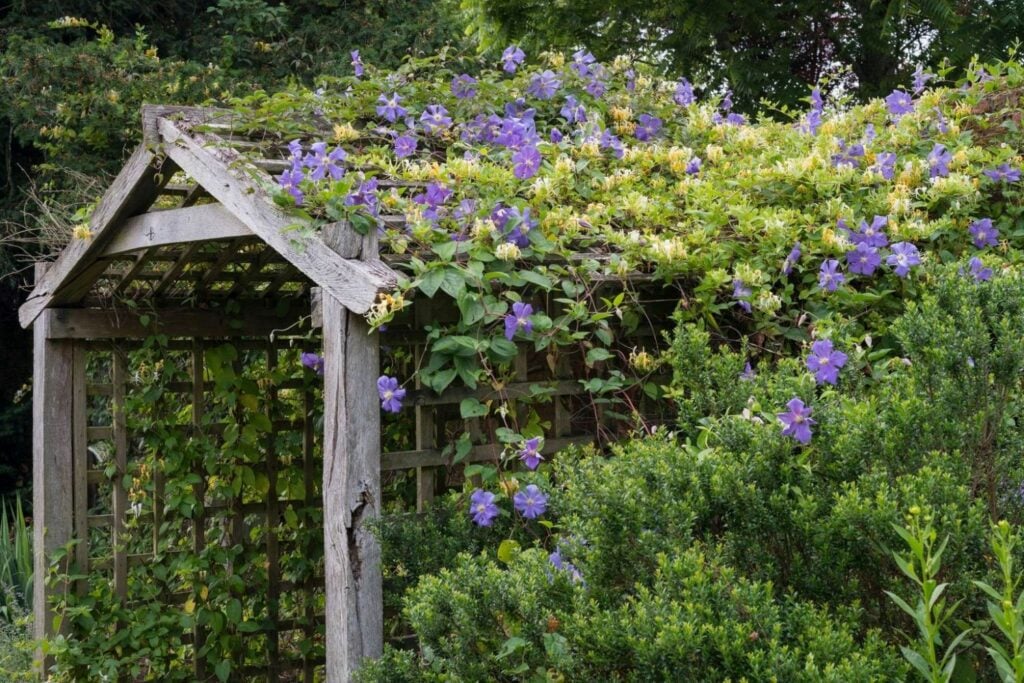
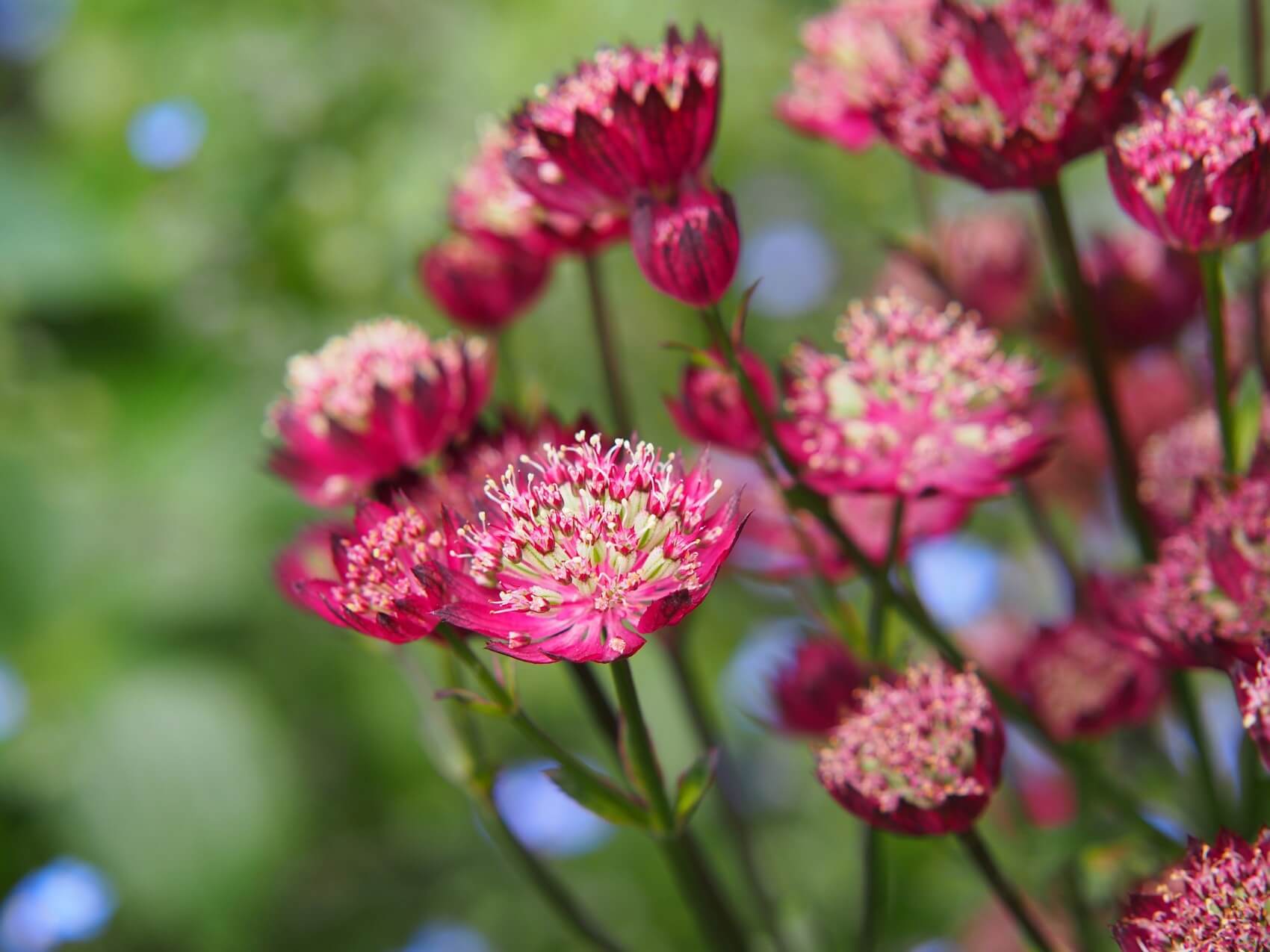
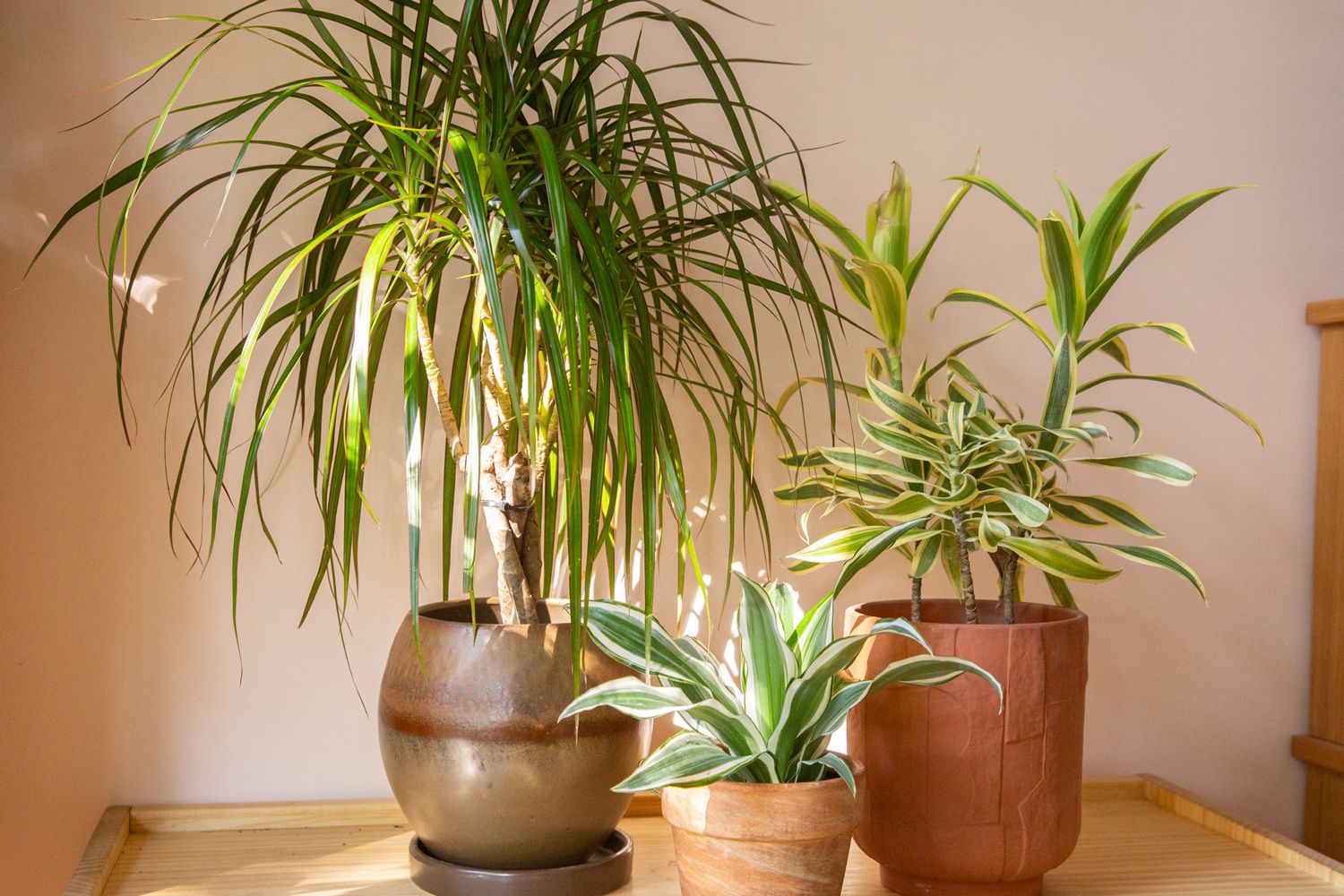
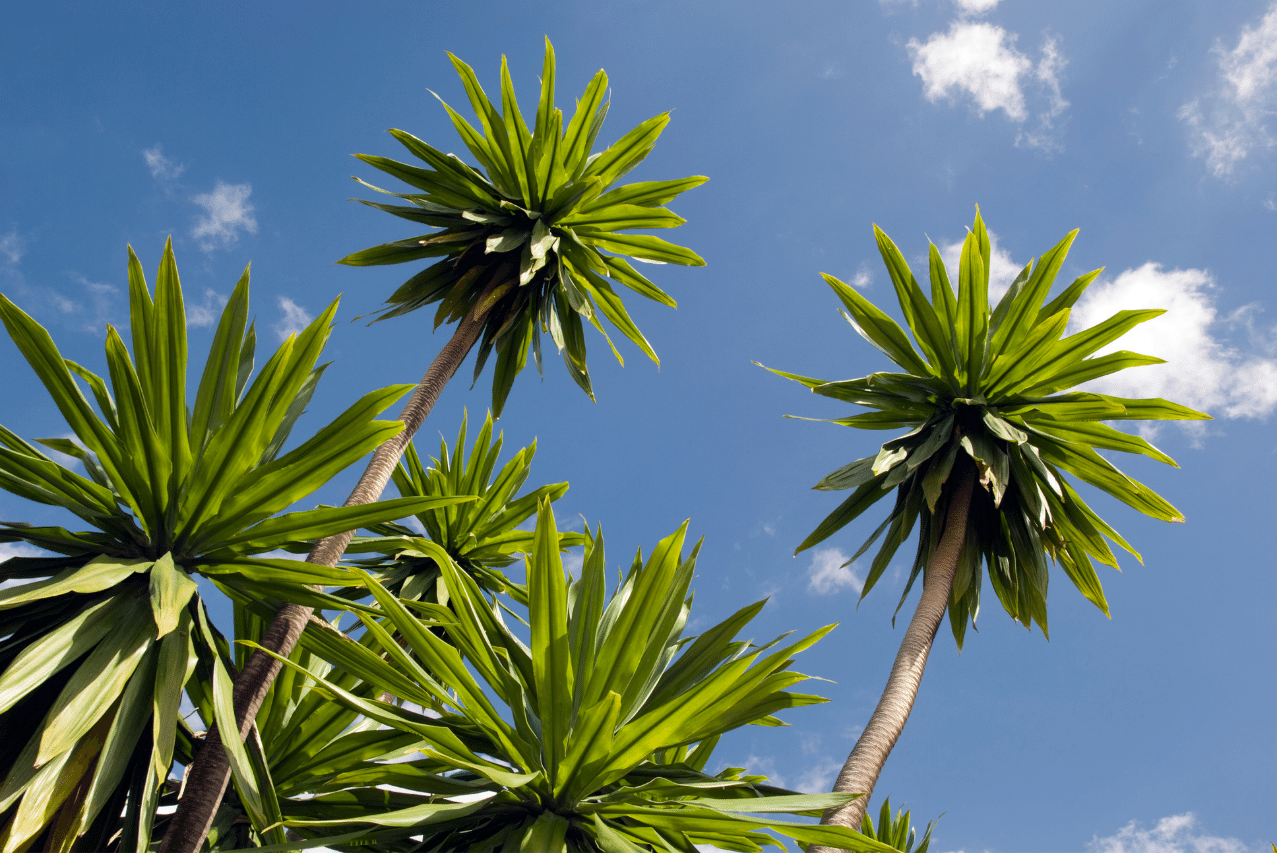
![Zinnia Planting and Caring Guide [UK]](https://staging.thearches.co.uk/wp-content/uploads/Zinnia-Plant-Care-Growing-Tips.jpg)
